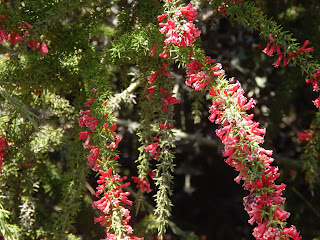Crassula coccinea. This bright-flowering crassula is usually a bit more densely populated with vibrant green leaves.
Staying on the South Africa hill, here's a low growing succulent (Glottiphylum longum).
A caudiciform is a plant that has a pronounced and usually fat trunk called a caudex. Caudiciforms run the gamut in the forms they take. Here's a Cyphostemma juttae. Known as Wild Grape, it's a slow growing deciduous succulent shrub that will eventually get to 6' tall.
Erica vestita (white flowering form). I love heathers and this is certainly a pretty one.
Neither my botanist friend nor I could be absolutely certain which restio this might be. Restio is both a genus, all the species of which are native to South Africa, and the common name for a group of grass or reed-like plants that take attractive forms. They are often highly sought after.
Veronia capensis. This white-blooming species of ironweed has made a nice mat over one of the S. Africa hill slopes.
I couldn't find the sign for this dense mat-forming succulent but I thought it looked cool, adding some green in the crevice between two rocks.
There's a wonderful pond in the Japanese Garden area of the Garden. This time of year lily pads cover a good portion of it.
Here's a closeup of two of the water lilies in bloom. Water lilies have a complex pollination process and rely on a host of insects to get the job done. Among others, flies, beetles and bees all are drawn to the nectar these flowers produce.
We couldn't find the sign for this Roscoea so we're uncertain as to which species it is. Lovely though.
Likewise, we're not sure which species of Dyckia this is and getting too close to look can be injurious to one's health (Dyckias are famous for their extremely sharp spines).
Here's a flower most of you will recognize - Hollyhock. A proper English garden flower! Below is a plant that's as uncommon as hollyhocks are instantly recognizable. It's Colletia ulicina and it was in full glorious bloom!
Another flower you will no doubt recognize - Fuchsia. Again, a sign could not be located but it was in the Central and South America section of the garden, areas where many Fuchsia species hail from.
Luma apiculata. This Myrtle family member hails from the central Andes, between Chile and Argentina. Though each flower is small, we caught it in full flower, smothering the green leaves in a white coat.
No sign and neither of us recognized this floriferous plant. Very fuzzy flowers that ranged from pale pink to rose-pink.
Though Eucalyptus trees are common, some, like this species with a white trunk and aromatic foliage, provide plenty of appeal.
We found this Amaranth in the edibles garden. Traditional peoples harvested the seed to use in cooking and used the colorful flowers to make dyes.
I didn't recognize these two milkweeds though my friend did. This first one is Asclepias linaria. It is sometimes known as pineneedle milkweed.
This second member of the Asclepias genus is A. glaucescens. Its down-turned flowers have given it the common name of Nodding milkweed.
My friend knew this was one of the many 'fan palms' but wasn't sure which one exactly. He thought perhaps a member of the Sabal genus, known as Dwarf palmetto. Any experts out there to ID it?
Dianella species. This grass-like perennial produces dainty blue flowers but it's the blue berries that follow that tend to be the reason for adding it to one's garden.
Calceolaria tomentosa. This large member of the pocketbooks genus hails from Peru. Not only does the plant get big but the individual flowers are considerably larger than those of the ones you find in your local nursery.
Another unfamiliar (to me) shrub that was laden with eye-catching flowers, this Brachyotum ledifolium hails from Ecuador and produces small fruits that are edible.
Contrary to the popular idea that all ferns like shade, this Cheilanthes myriophylla can handle the sun. An extremely rare species hailing from Mexico south to Peru, it forms an attractively dense mound.
Macleania benthamiana. This shrub with pendent branches hails from Columbia and Ecuador. It too produces edible fruit.
Near the front entrance to the Garden is a Leucospermum reflexum. This specimen is the yellow flowering form of it. That's it to left of center.





































































